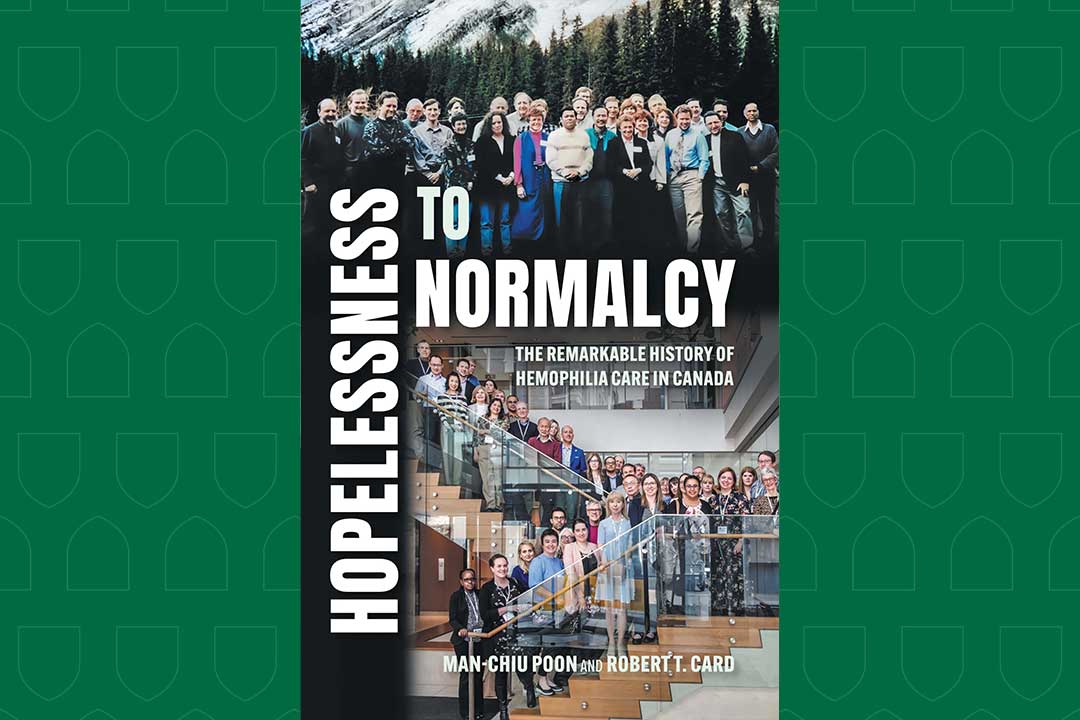
Guest Columnist: USask Professor Emeritus Dr. Bob Card
Dr. Bob Card, a retired academic hematologist whose career spanned more than five decades, has co-authored a new book
By Dr. Robert T. CardHopelessness to Normalcy: The Remarkable History of Hemophilia Care in Canada is a recently published book that traces the remarkable evolution of hemophilia care in Canada. My co-author Dr. Man-Chiu Poon (Emeritus Professor, University of Calgary) and I are retired hematologists (both members of our respective university retirees’ groups) and we each have more than five decades of experience in hemophilia care. Our book begins with the initial description of the hereditary bleeding disorder, which became known as hemophilia, in the second century AD. The book subsequently concentrates on the evolution of hemophilia and other bleeding disorder programs in Canada, which began in the 1950s and continue to flourish to the present day.
Our methodology included: (1) review of literature and archived material; (2) 80 interviews of doctors, other health-care professionals (e.g. nurses), and patients; and (3) personal experiences of the authors over the years. The book was formally launched this year at the national hemophilia meetings in Winnipeg in May and the Canadian Society for the History of Medicine in Toronto in June.
The remarkable portion of the history relates to what USask historian Dr. Erika Dyck (BA’98, MA’00, PhD) has called a “rollercoaster” effect given the swings over the years in patient prognosis between hopelessness and normalcy, as well as to the resilience of both the medical and lay groups in continuing to work together following what has been described as an unspeakable patient tragedy.
Prior to the 1950s, the prognosis for a person with hemophilia was indeed hopeless. In William Osler’s first edition of Principles and Practice in Medicine 1892, he pointed out that less than 50 per cent of hemophiliacs would reach their teen years. Crippling joint damage with severe pain was universal. Despite advances in diagnosis and blood transfusion during the first half of the 20th century, this prognosis was basically unchanged until the early 1950s.
Beginning at that time, the development of plasma therapy and various concentrated forms of replacement factor (much of which could be given at home), plus the development of dedicated multidisciplinary hemophilia clinics, led to a progressive improvement in prognosis. By the spring of 1982, at a major national hemophilia meeting held in Saskatoon, the speakers and patients alike realized that normalcy had been achieved, with expected life span near normal.
However, this was abruptly interrupted by the unexpected tragedy of the “tainted blood era” due to unsafe blood products. The first cases in hemophiliacs were reported in early summer 1982 and this rapidly had a devastating effect on persons with hemophilia. Within the next several years, the majority of severe hemophiliacs across Canada were infected with HIV/AIDS and passed away. Most were boys and young men. This situation, dramatized from the patient point of view in the CBC series Unspeakable, became hopeless again. Our book is presented from the point of view of health-care professionals.
During the late 1980s and through subsequent years, advances were made in therapeutics to remove the risk of blood-borne infections from products used by persons with hemophilia. The multidisciplinary hemophilia programs were strengthened in 1994 by the development of the Association of Hemophilia Clinic Directors of Canada (AHCDC), which celebrated its 30th anniversary last year. Newer therapies such as gene therapy continue to be developed so that normalcy has been achieved again, with expected life span back to normal.
While the overall story is Canadian, there are many Saskatchewan ties. Indeed, in 1970, Dr. Brian McSheffrey, a full-time member of the USask pediatrics department at the time, developed at Saskatoon’s Royal University Hospital one of the first dedicated hemophilia clinics outside of Montreal. Subsequently, Caryl Bell (BSN’65) became one of the first dedicated-funded hemophilia nurses in Canada. Caryl was the spouse of the late Dr. Dick Bell (BAPE’64), a USask kinesiology professor. There are interview quotes from one Saskatchewan person with hemophilia, born in 1952 and deceased (unrelated to hemophilia) this year, whose life story spanned the entire “roller-coaster” era of hopelessness to normalcy, and back again.
These stories, and much more, can be found in our book published by FriesenPress. Further information about the book and where it is available can be found on the website: www.hopelessnesstonormalcy.ca.


